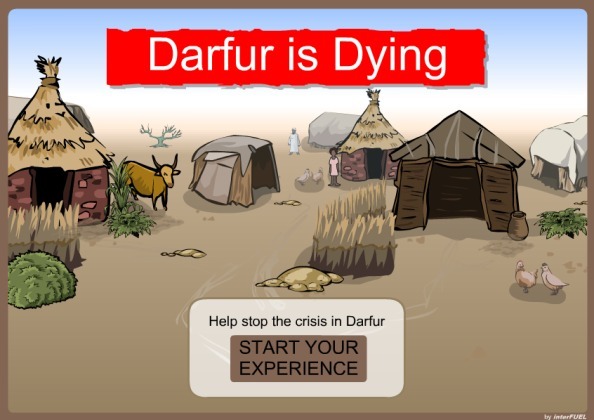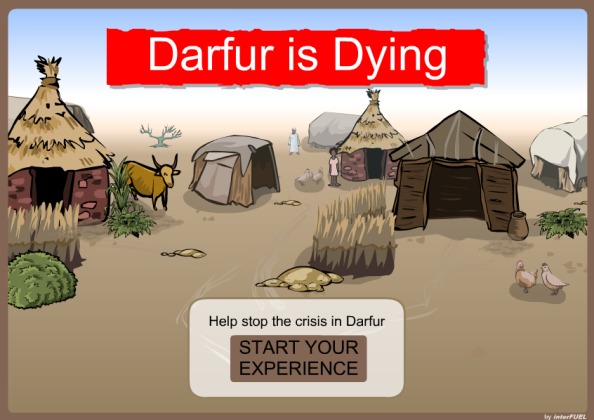
Crédit DR
It’s tempting to simplify the idea of the video game to a mere distraction reserved for young men in search of an adrenaline rush, bent on massacring zombies and saving damsels in distress. It’s supposedly just a gearwheel in this “showbiz society”, that is in the end just like any other, with the small exception that it’s under the guise of “interactivity” so it maintains the illusion that players are responsible for their actions. Viewed as cathartic at best by enabling the player to satisfy their animalistic urges, these games, version 2.0, are supposedly just a geek factory; that is to say, literally, circus freaks, incapable of differentiating virtual fantasies from real life.
Regarded as juvenile or even dangerous and bombarded with uproar about the ethics of its content, for about a decade video game production has nevertheless experienced a somewhat unexpected phenomenon: serious gaming. Made possible by the popularization of amateur “mods,” or additional content developed from already existing games, a new alternative and pedagogical way of gaming is emerging. It seems that as of now playing is really thinking, as is confirmed by Shuen-Shing Lee in a 2010 article published in the French newspaper Le Monde. Already, the UN, the Red Cross, and Amnesty International approve of this movement in producing and supporting such games as Darfour is Dying, 3D Worldfarmer, and Food Force. Between humanitarian action, the struggle against AIDS and raising awareness of Israeli-Palestinian conflict, the opportunities for serious games since seem infinite.
Serio Ludere : Entertainment as Education and the Emergence of Serious Games
What at first glance looks like an oxymoron is, on the contrary, not a new phase in game usage in a broad sense. Even during the Renaissance, represented by the expression Serio Ludere, amusement was at the center of literary tools used to aid understanding. Twisting and bending the rules, and defying the weight of reality in order to spread a wider reflection on a theme and better understand it, have never been strangers to play. What’s better than a sandbox to leave the rest to the imagination in finding innovative solutions? Far from being trivial, games have always been upheld as practical applications. Prussian Kriegspiels, ancestors of virtual war-games, were thus valued by generals, taught in the regiments and established before the time when realistic models of potential conflict situation were formed.
The video game didn’t have any reason, therefore, to not take part in this dynamic. The international environment and its many crises were therefore the breeding ground of numerous creative licenses and first-person shooter games, but especially games with an array of strategic simulations, from Age of Empires to Civilization, to name a few. Although their role wasn’t primarily pedagogical, these games were already integrating the “serious” aspect and allowing their users to familiarize themselves with environments they would never have otherwise known.
However, the serious game goes further than its predecessors, because whereas the latter were using reality as a pretext, the serious game uses it as the material and objective of its gameplay, of its rules and its functioning. By asking the player to invest themselves in a game whose objective is no longer fundamentally to be entertaining, but to raise awareness of some cause or problem, this new video game production is a veritable divergence from the traditional conventions of video games.
The idea of a “victory” and/or an “end” of the game, although central to the user’s interest, becomes an integral part of a message and is often impossible to attain. “September 12th” designed by Gonzalo Frasca in 2003 is emblematic of this. Flying over a city in the Middle East, the explicit objective is to eradicate the terrorist presence at the risk of collateral damage. Although at first glance, neither the concept nor the content are new: eliminating a growing number of enemies, it is in the conclusion that the game inspires reflection. It is truly impossible to win while keeping with long-standing guidelines. Eliminating terrorists is an immediate solution that can certainly seem effective, but due to the civilian losses that it engenders, the population will soon be entirely rebellious.
For those still unconvinced, serious games also distinguish themselves from purely “educational” games by being directly aimed at the player’s autonomy and critical thinking, sometimes going so far as to verge on the non-game as with Paris Riots, developed sometime around the 2005 urban riots. Embodying a patrol officer from the French riot police, the CRS, and in charge of containing the disorder, you don’t encounter anyone, turning what should have been a shooter game into a decidedly long stroll. Criticizing the governments and underlining the absurdity of certain politics, serious games are therefore not just limited to political games, uniquely dedicated to power struggles and accusations. Indeed, more and more, they are now widely used by NGOs and academics in campaigns for conflict and humanitarian issue awareness.
“Feeding the Mind” : Serious Games, an Integral Part of Awareness Campaigns for Humanitarian Aid
Aware that video games are presently structured as a new form of media with the particular ability to affect at once the working population and youth, NGOs stepped onto the scene in 2005 with Food Force. Developed by the World Food Programme, the United Nations’ food aid organization, their mission was to inform about programs and possible efforts to combat hunger, by confronting players with realistic challenges to quickly feed millions of people. It was attached to a website where users could enquire about the organization’s current projects. Lastly, it was desired to be an educational resource for teachers. This first initiative was then confirmed by games like Free Rice in 2007 and Fast Car in the context of the struggle against AIDS in 2010. The game allows for the approachability of serious issues all while being interactive. More than with film, where we remain spectators, playing allows us to directly personify a character. The emotional impact of this possibility will be stronger and the interest increased tenfold, as seen in “Ayiti: The Cost of Life” from 2006, launched by the non-profit organization Global Kids, or even “Darfur is Dying,” which came out in 2006. In the latter, the creators, wishing to bring attention to the civil war in Sudan, have the player choose a family member from a refugee camp and make him or her survive in their daily tasks. Having to fetch water, irrigate crops, and distribute medicine allows the player to be at once informed about the difficulties of humanitarian aid but also about the people’s situations.
In fact, serious games allow one to underline the possibilities of cooperation there are by altering the other’s point of view and making it familiar. Peacemaker decided to take on Israeli-Palestinian conflict, giving the choice to play either the Israeli prime minister or the representative of the Palestinian authority with the mission to achieve peace. Presented to people from the regions in question, the response was very positive, allowing each player to see and act in the game through the other and better understand them. Strongly successful, the game was even used in high schools within the two populations, reaching 3,000 students in 2009 according to the Peres Center for Peace.
What to expect from serious gaming ?
Today, met with a great rise in usage, generating 1.5 billion euros in France alone, serious gaming is now far ahead of the amateur mods of its early days. It’s a tool used in multiple institutions, such as governments with Ecobudget and international organizations, and even the American armed forces with America’s Army. As a result, some see in it as a potential risk for citizens. The game, while it is divergent and begs for reflection, all while bending the established rules and claiming to be alternative, remains above all a purveyor of rules in a world of limited, if not absent, diversity. Liberator then can be revealed, by contrast, as a tool of to create uniformity and conformation of individuals and ideologies. The game Special Force produced by the Hezbollah is one upsetting example.
Now that it’s a form of media like any other, perhaps it’s time then that the video game become more democratic, open to all in its creation and access. Currently just a humanitarian and public policy tool, why couldn’t it be a tool for citizens? Developing a journalistic game could perhaps be a way of questioning our news, of lowering language barriers, and lastly making all information accessible. Some, like Arte for example with FortMcMoney or Impactgame and its Play the News, seem to be leading the way. Let’s hope then that serious doesn’t become casual.




























